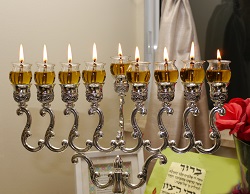 First question: Why is the pictured lamp stand more authentic and correct as a part of the Hanukkah celebration than the usual candelabra?
First question: Why is the pictured lamp stand more authentic and correct as a part of the Hanukkah celebration than the usual candelabra?
Answer: Because the whole story of Hanukkah is about oil, not candles.
Second question: Should there be seven or nine branches on a menorah?
Answer: It depends. . . .
The menorah (Hebrew for “lamp”), or lamp stand, that was used in the ancient Temple had seven branches and was made of pure gold. It was to be kept burning day and night, using sacred oil. The number seven in the Bible is often seen as a symbol of perfection. The Hanukkah menorah, on the other hand, has nine branches, eight of them for the eight days of the festival and the middle one, called the “shamash,” (“helper”) to be used for lighting the other eight, one candle or lamp per day.
But why does Hanukkah last for eight days to begin with?
The story behind the holiday is that there was only enough sacred oil in a sealed flask to keep the Temple menorah going for one day, but the oil miraculously lasted for eight. Why not 10 days, or 12? I actually found two answers. One was that no more oil could be prepared until after seven days had passed, since all of the Jewish rebels who re-took the Temple from the occupying Greeks were soldiers and had been in contact with dead bodies. They had to wait a week before being considered clean and then on the eighth day could prepare new oil. There also seems to be the idea that it was going to take eight days to go and get more oil, but I haven’t seen any real explanation of this idea. It was simply clarified olive oil, which should have been readily available. Either way, the flame lasted until the new supply could be used. The word “Hanukkah” (or “Chanukah,” or any one of a number of spellings possible, since the word is a transliteration from Hebrew, which has a different alphabet from that of English) means “dedication,” referring to that of the men who fought to re-take the Temple and also to the oil itself. Eventually, though, as wax candles became more common, the switch was made to using those for the Hanukkah lights. They’re a lot easier to deal with–less messy and easier to store.
Note: I wrote the above material before doing a deep dive into this whole “sacred oil” idea. So the above is perfectly in line with what the typical Hanukkah backstory would say, and rather than re-writing this whole thing I’m going to direct you to a greatly-revised version of another post, “Why Are Latkes Associated So Strongly with Hanukkah?” that will give you a fuller understanding of the story about the eight-day miracle associated with the holiday.
This post was originally written as background material for a concert by my own choir, the Cherry Creek Chorale in the Denver area. We were singing the selection “Eight Candles in My Window,” with words and music by Brent Hardesty. We’ve sung many other pieces about this holiday, which you can access by using the “categories” option on the sidebar of this blog.
No YouTube video available for Hardesty’s song, alas, but here’s another nice one:
© Debi Simons

